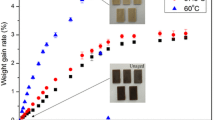Abstract
Natural composites have been important materials system due to preservation of earth environments. Natural fibers such as jute, hemp, bagasse and so on are very good candidate of natural composites as reinforcements. On the other hand regarding matrix parts thermosetting polymer and thermoplastic polymer deriver form petrochemical products are not environmental friendly material, even if thermoplastic polymer can be recycled. In order to create fully environmental friendly material (FEFM) biodegradable polymer which can be deriver from natural resources is needed. Therefore poly(lactic acid) (PLA) polymer is very good material for the FEFM. In this paper jute fiber filled PLA resin (jute/PLA) composites was fabricated by injection moldings and mechanical properties were measured. It is believable that industries will have much attention to FEFM, so that injection molding was adopted to fabricate the composites. Long fiber pellet fabricated by pultrusion technique was adopted to prepare jute/PLA pellet. Because it is able to fabricate composite pellets with relative long length fibers for injection molding process, where, jute yarns were continuously pulled and coated with PLA resin. Here two kinds of PLA materials were used including the one with mold releasing agent and the other without it. After pass through a heated die whereby PLA resin impregnates into the jute yarns and sufficient cooling, the impregnated jute yarns were cut into pellets. Then jute/PLA pellets were fed into injection machine to make dumbbell shape specimens. In current study, the effects of temperature of PLA melting temperature i.e. impregnation temperature and the kinds of PLA were focused to get optimum molding condition. The volume fractions of jute fiber in pellet were measured by several measuring method including image analyzing, density measurement and dissolution methods. Additionally, thermal and mechanical properties were investigated. It is found that 250° is much suitable for jute/PLA long fiber pultrusion process because of its less heat degradation of jute, better impregnation, acceptable mechanical property and higher production efficiency. Additionally the jute fibers seem much effective to increase deflection temperature under load, tensile modulus and Izod strength.












Similar content being viewed by others
Abbreviations
- FEFM:
-
Fully environmental friendly material
- PLA:
-
Poly(lactic acid)
- LFT:
-
Long fiber pellet fabricated by pultrusion technique
- Jute/PLA:
-
Jute fiber filled PLA resin
- DTUL:
-
Deflection temperature under load
- TGA:
-
Thermogravimetry
- DSC:
-
Differential scanning calorimetry
References
Okubo K, Fujii T, Yamamoto Y (2004) Compos A 35:377
Arbelaiz A, Fernández B, Ramos JA, Retegi A, Llano-Ponte R, Mondragon I (2005) Compos Sci Technol 65:1582
Doan TTL, Gao SL, Mäder E (2006) Compos Sci Technol 66:952
Park JM, Quang ST, Hwang BS, DeVries KL (2006) Compos Sci Technol 66:2686
Doan TTL, Brodowsky H, Mäder E (2007) Compos Sci Technol 67:2707
Madsen B, Hoffmeyer P, Thomsen AB, Lilholt H (2007) Compos A 38:2194
Madsen B, Hoffmeyer P, Lilholt H (2007) Compos A 38:2204
Park JM, Kim PG, Jang JH, Wang Z, Hwang BS, DeVries KL (2008) Compos B 39:1042
Sgriccia N, Hawley MC, Misra M (2008) Compos A 39:1632
Mukherjee T, kao N (2011) J Polym Environ 19:714
Ji SG, Cho D, Park WH, Lee BC (2010) Macromol Res 18:919
Plackett D (2004) J Polym Environ 12:131
Takatani M, Lkede K, Sakamoto k, Okamoto T (2008) J Wood Sci 54:54
Ki-Wook K, Byoung-Ho L, Hyun-Joong K, Klanarong S, Dorgan JR (2012) J Therm Anal Calorim 108:1131
Ren J (2011) Biodegradable poly(lactic acid): synthesis, modification, processing and application. Springer, Heidelberg, Dordrecht, London, New York, pp 38–141
Yussuf AA, Massouni I, Hassan A (2010) J Polym Environ 18:422
Li S, Wang C, Zhuang X, Hu Y, Chu F (2011) J Polym Environ 19:301
Petinakis E, Yu L, Edward G, Dean K, Liu H et al (2009) J Polym Environ 17:83
Mohanty AK, Misra M, Drzal LT (2002) J Polym Environ 10:19
Ohta T, Takai Y, Leong Y, Hamada H (2009) Polym Polym Compos 46:487
Yang Y, Ohta T, Morii T, Hamada H (2011) J Mater Sci 46(2011):2678
ISO 1172 (1996)
Author information
Authors and Affiliations
Corresponding author
Rights and permissions
About this article
Cite this article
Yang, Y., Murakami, M. & Hamada, H. Molding Method, Thermal and Mechanical Properties of Jute/PLA Injection Molding. J Polym Environ 20, 1124–1133 (2012). https://doi.org/10.1007/s10924-012-0565-8
Published:
Issue Date:
DOI: https://doi.org/10.1007/s10924-012-0565-8




